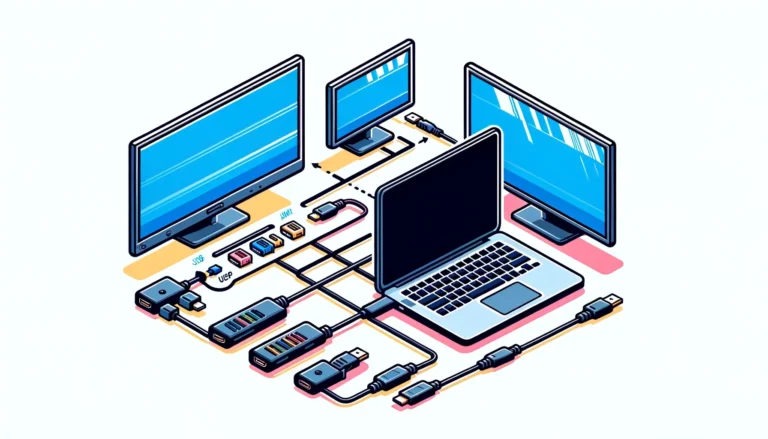In today’s fast-paced world, having a dual-monitor setup is more than a luxury—it’s a game-changer. Let’s learn how to connect 2 monitors to a laptop, enhancing productivity and multitasking. This guide simplifies the setup process, ensuring a seamless dual-monitor experience for work or play. Whether you’re a gamer, a designer, a coder, or just someone looking to get more done, adding a second monitor to your laptop can take your work and play to a whole new level. This guide is your friendly walkthrough on how to connect two monitors to your laptop, ensuring a smooth and efficient setup.
The Power of Two: Why Dual Monitors?
Think about it: being able to drag items from one screen to another without the constant back-and-forth of switching tabs. Imagine yourself researching on one screen while drafting a report on the other, merging data analysis with content creation without missing a beat.
But it’s not just about productivity. It’s about comfort, too. Setting up your monitors just right can save you from the dreaded eye strain and neck pain, making those long hours in front of the screen a bit more bearable.
And let’s not forget teamwork. Sharing your screen in a meeting while keeping your notes and data on hand can make collaborations smooth and effective, ensuring you’re always on top of your game.
Getting Ready for Dual Monitors
Before diving in, you’ll need a few things:
- A laptop with a video output (like HDMI, VGA, or DisplayPort).
- Two monitors that match your laptop’s video output.
- The right cables for the connection.
- Possibly a USB C hub if your laptop mainly has USB C ports.
Compatability is crucial. Make sure your laptop can handle multiple displays and that your ports and cables are all on the same page.
how to connect 2 monitors to a laptop: A Step-by-Step Guide
Check your laptop’s ports and capabilities.
Look for available ports (HDMI, DisplayPort, Thunderbolt, and USB-C).
- Ensure your laptop’s graphics card supports the resolutions you want.
Pick the Right Cables:HDMI for high-definition audio and video.
- DisplayPort for higher bandwidth, supporting better resolutions and refresh rates.
- Thunderbolt for high-speed data transfer along with video and audio.
- USB-C to HDMI/DisplayPort Adapter if you’re limited to USB-C ports.
Connect the Monitors: Link the monitors to your laptop using the chosen cables or adapters.
Tweak Your Display Settings: Right-click on the desktop, go to “Display Settings,” and choose to extend or mirror your displays.
- Adjust resolution, orientation, and color calibration to your liking.
Install graphics drivers (for Windows users): Find your graphics card details (Windows Key + R, type “dxdiag”).
- Download and install the latest drivers from your graphics card manufacturer’s website.
Troubleshooting Tips:
- Check all connections.
- Try different cables if you suspect a faulty one.
- Update your graphics drivers.
- Confirm the compatibility of the graphics card with the desired resolutions and refresh rates.
- Restart your laptop if all else fails.
Connecting Two Monitors to a MacBook
MacBooks offer a sleek way to expand your workspace. Depending on your model, you’ll have different ports (Thunderbolt 3 (USB-C), HDMI, and Mini DisplayPort). Make sure your monitors have compatible input ports, or get the necessary adapters.
Check Compatibility and Ports: Identify the ports on your MacBook and ensure your monitors match or get the right adapters.
Get Cables and Adapters: Match the cables to your ports or get adapters if needed.
Connect the Monitors: Use the cables or adapters to connect each monitor to your MacBook.
Configure Display Settings: Your MacBook should detect the monitors automatically. Go to ‘System Preferences’ > ‘Displays’ to arrange and configure your displays.
Adjust Resolution and Orientation: Set the resolution and scale for each monitor. Adjust orientation if needed.
Test your setup: Drag applications or windows between screens to ensure everything is working smoothly.
Beyond the Basics: Optimizing Your Setup
Once you’re connected, it’s time to make it comfortable. Adjust the brightness, contrast, and position of your monitors. Consider a monitor stand for better desk space utilization. Customize your backgrounds for easy screen identification, and master keyboard shortcuts for efficient navigation.
The Big Picture: Benefits of Dual Monitors
Dual monitors aren’t just about doing more; they’re about experiencing more. From seamless multitasking to immersive gaming, the benefits are vast. Games with dual-monitor support offer a panoramic view, taking your gaming experience to a whole new level.
Embarking on Your Dual-Monitor Journey
With the right tools and this guide, setting up dual monitors is an adventure worth taking. It’s not just about enhancing productivity; it’s about transforming your digital interaction and ergonomic health. Welcome to the world of dual screens, where your capabilities aren’t just added—they’re multiplied. Happy multitasking!
Read here For more such content .

1 thought on “How to Connect 2 Monitors to a Laptop: A Comprehensive Guide”